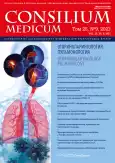Functional and organic dysphonia in voice professionals (lecture)
- Authors: Stepanova J.E.1
-
Affiliations:
- Saint Petersburg Research Institute of Ear, Throat, Nose and Speech
- Issue: Vol 25, No 9 (2023): Otorhinolaryngology and pulmonology
- Pages: 629-635
- Section: Articles
- URL: https://journals.rcsi.science/2075-1753/article/view/253580
- DOI: https://doi.org/10.26442/20751753.2023.9.202387
- ID: 253580
Cite item
Full Text
Abstract
An urgent task of otorhinolaryngology (phoniatry) is the diagnosis and treatment of disorders of voice function in voice professionals or persons of voice-speech professions. An undiagnosed laryngeal disease worsens the quality of life of patients, creates difficulties in communication and can even lead to professional unfitness, because the patient does not withstand the necessary vocal load. The leading role in the modern diagnosis of laryngeal diseases belongs to endoscopic research methods – video endoscopy and video endostroboscopy. All disorders of voice function are classified as functional and organic. Recent studies have shown that from 30.5 to 40% of voice professionals who have applied for phoniatric care suffer from functional disorders. Functional changes are understood to mean changes in which laryngoscopic examination does not always reveal any visible pathology. But with the help of special research methods, such as stroboscopy (videostroboscopy), spectral analysis of the voice, pathognomonic changes can be determined, and the patient presents characteristic complaints. More often than others, hypotonic and hypo-hypertonic dysphonia are diagnosed. Organic laryngeal diseases are characteristic of 69.5% of patients with dysphonia. They are represented by various nosological forms. Certain difficulties arise in the diagnosis of professional laryngitis and vascular pathology of the larynx. The lecture presents pathognomonic clinical changes of the larynx in voice professionals, knowledge of which is necessary for practical doctors to make a diagnosis.
Full Text
##article.viewOnOriginalSite##About the authors
Julia E. Stepanova
Saint Petersburg Research Institute of Ear, Throat, Nose and Speech
Author for correspondence.
Email: julia.stepanov@yandex.ru
ORCID iD: 0000-0003-1502-6337
D. Sci. (Med.), Assoc. Prof., Saint Petersburg Research Institute of Ear, Throat, Nose and Speech
Russian Federation, Saint PetersburgReferences
- Василенко Ю.С. Голос. Фониатрические аспекты. М.: Дипак, 2013 [Vasilenko IuS. Golos. Foniatricheskie aspekty. Moscow: Dipak, 2013 (in Russian)].
- Степанова Ю.Е., Корень Е.Е., Готовяхина Т.В. Клинико-диагностический алгоритм работы врача-оториноларинголога с профессионалами голоса. Российская оториноларингология. 2019;18(1):116-23 [Stepanova YuE, Koren’ EE, Gotovyakhina TV. Clinical and diagnostic algorithm for otorhinolaryngologist’s work with voice professionals. Rossiiskaya otorinolaringologiya. 2019;18(1):116-23 (in Russian)]. doi: 10.18692/1810-4800-2019-1-116-123
- Максимов И. Фониатрия. М.: Медицина, 1987 [Maksimov I. Foniatriia. Moscow: Meditsina, 1987 (in Russian)].
- Приказ Минздрава России от 12 ноября 2012 г. №905н «Об утверждении порядка оказания медицинской помощи населению по профилю “оториноларингология”» [Prikaz Minzdrava Rossii ot 12 noiabria 2012 g. №905n «Ob utverzhdenii poriadka okazaniia meditsinskoi pomoshchi naseleniiu po profiliu “otorinolaringologiia”» (in Russian)].
- Степанова Ю.Е., Швалев Н.В. Применение видеостробоскопии для диагностики, лечения функциональных и органических заболеваний гортани: пособие для врачей. СПб., 2000 [Stepanova IuE, Shvalev NV. Primenenie videostroboskopii dlia diagnostiki, lecheniia funktsional'nykh i organicheskikh zabolevanii gortani: posobie dlia vrachei. Saint Petersburg, 2000 (in Russian)].
- Pereira ER, Tavares EL, Martins RH. Voice disorders in teachers: clinical, videolaryngoscopical, and vocal aspects. J Voice. 2015;29(5):564-71. doi: 10.1016/j.jvoice.2014.09.019
- Kwok M, Eslick GD. The Impact of Vocal and Laryngeal Pathologies Among Professional Singers: A Meta-analysis. J Voice. 2019;33(1):58-65. doi: 10.1016/j.jvoice.2017.09.002
- Готовяхина Т.В., Степанова Ю.Е., Корень Е.Е. Влияние пандемии COVID-19 на заболеваемость гортани. Российская оториноларингология. 2022;21(4):29-34 [Gotovyakhina TV, Stepanova YuE, Koren EE. Impact of COVID-19 on laryngeal morbidity. Rossiiskaya otorinolaringologiya. 2022;21(4):29-34 (in Russian)]. doi: 10.18692/1810-4800-2022-4-29-34
- Степанова Ю.Е., Артюшкин С.А., Готовяхина Т.В. Заболевания гортани у лиц голосоречевых профессий. СПб.: Полифорум, 2018 [Stepanova IuE, Artiushkin SA, Gotoviakhina TV. Zabolevaniia gortani u lits golosorechevykh professii. Saint Petersburg: Poliforum, 2018 (in Russian)].
- Hirano M, Bless DM. Videostroboscopic examination of the larynx. San-Diego: Singular, 1993.
- Степанова Ю.Е., Готовяхина Т.В., Махоткина Н.Н. Важность своевременной диагностики заболеваний гортани при первичном осмотре врачом-оториноларингологом. Медицинский совет. 2018;20:58-64 [Stepanova YuE, Gotovyakhina TV, Makhotkina NN. Importance of timely diagnosis of diseases of the larynx during initial examination performed by an otorhinolaryngologist. Meditsinskiy sovet=Medical Council. 2018;20:58-64 (in Russian)]. doi: 10.21518/2079-701X-2018-20-58-64
- Van Houtte E, Van Lierde K, Claeys S. Pathophysiology and treatment of muscle tension dysphonia: A review of the current knowledge. J Voice. 2011;25(2):202-7. doi: 10.1016/j.jvoice.2009.10.009
- Ермолаев В.Г., Лебедева Н.Ф., Морозов В.П. Руководство по фониатрии. Ленинград: Медицина. Ленинградское отделение, 1970 [Ermolaev VG, Lebedeva NF, Morozov VP. Rukovodstvo po foniatrii. Leningrad: Meditsina. Leningradskoe otdelenie, 1970 (in Russian)].
- Степанова Ю.Е. Профессиональные заболевания гортани у лиц голосоречевых профессий. Профессиональные болезни верхних дыхательных путей и уха: руководство для врачей. Под ред. В.И. Бабияка, Я.А. Накатиса. СПб.: Гиппократ, 2009 [Stepanova IuE. Professional'nye zabolevaniia gortani u lits golosorechevykh professii. Professional'nye bolezni verkhnikh dykhatel'nykh putei i ukha: rukovodstvo dlia vrachei. Pod red. VI Babiiaka, IaA Nakatisa. Saint Petersburg: Gippokrat, 2009 (in Russian)].
- Оториноларингология: национальное руководство. Под ред. В.Т. Пальчуна. М.: ГЭОТАР-Медиа, 2016 [Otorinolaringologiia: natsional'noe rukovodstvo. Pod red. VT Pal'chuna. Moscow: GEOTAR-Media, 2016 (in Russian)].
- Степанова Ю.Е., Коноплев О.И., Готовяхина Т.В., и др. Острые и хронические ларингиты у профессионалов голоса. Вестник оториноларингологии. 2019;84(1):68-71 [Stepanova YuE, Konoplev OI, Gotovyakhina TV, et al. Acute and chronic laryngitis in the subjects engaged in the voice and speech professions. Vestnik Oto-Rino-Laringologii. 2019;84(1):68-71 (in Russian)]. doi: 10.17116/otorino20198401168
- Степанова Ю.Е., Готовяхина Т.В., Корнеенков А.А., и др. Комплексное лечение дисфоний у лиц голосоречевых профессий. Вестник оториноларингологии. 2017;82(3):48-53 [Stepanova YuE, Gotovyakhina TV, Korneenkov AA, et al. The combined treatment of dysphonia in the subjects engaged in the voice and speech professions. Vestnik Oto-Rino-Laringologii. 2017;82(3):48-53 (in Russian)]. doi: 10.17116/otorino201782348-53
- Национальная медицинская ассоциация оториноларингологов, Союз педиатров России. Острый ларингит. Клинические рекомендации. М., 2020 [Natsional'naia meditsinskaia assotsiatsiia otorinolaringologov, Soiuz pediatrov Rossii. Ostryi laringit. Klinicheskie rekomendatsii. Moscow, 2020 (in Russian)].
- Махоткина Н.Н., Степанова Ю.Е. Острый ларингит. Современные аспекты физиотерапевтического лечения с позиции синдромно-патогенетического подхода. Российская оториноларингология. 2022;21(6):114-9 [Makhotkina NN, Stepanova YuE. Acute laryngitis. Modern aspects of physiotherapy treatment with syndromic and pathogenetic approach. Rossiiskaya otorinolaringologiya. 2022;21(6):114-9 (in Russian)]. doi: 10.18692/1810-4800-2022-6-114-119
- Abitbol J. Atlas of laser voice surgery. San Diego: Singular, 1995.
Supplementary files

















